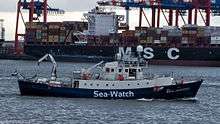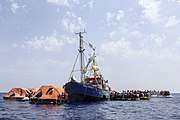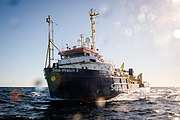Sea-Watch
Sea-Watch is a German non-governmental organisation that saves lives in the Mediterranean sea.
 Sea Watch 2 in the port of Hamburg on 21 March 2016 | |
| Established | 19 May 2015 |
|---|---|
| Founders | Harald Höppner |
| Headquarters | Berlin |
| Revenue | 1,608,109 euro |
History
1973 - Today: Context
Currently pursued border policy of the European Union member states dates back to early 1970-ies, when the end of the economic boom put an end to the need of cheap labor power.[1] Migrations continued, although they we now made illegal. Since the mid 1970s, more than 2.5 million persons have migrated over the Mediterranean Sea.
Chris Grodotzky describes three main routes: "The Western Route, with only 15 kilometres from northern Morocco to southern Spain. The Eastern Route, from Turkey to Greece, particularly busy between 2014 and 2016, when over a million refugees, mostly from Syria, Afghanistan and Iraq, beat their way towards central Europe. And the Central Mediterranean Route, which actually includes a number of long-distance routes through the Sicilian Channel, with Libya as the main hub of embarkation.
The Central Mediterranean route is by far the most dangerous passage, with more than 15.900 official reported deaths, since 2014, compared to 3.476 in the west and east, making it the deadliest border crossing in the world. [2] (At the same time, there are indications that the unknown number of lives lost in the Sahara, on the way to the Mediterranean Sea, could be even higher.[3])
The EU’s reaction to the mass dying on their southern border changed over time, as Paolo Cuttitta outlines: “until 2013 state authorities in the Mediterranean used to systematically discourage all seafarers – mainly fishing boats and cargoes – from accomplishing their duty to rescue people in distress at sea, in the frame of what has been called the ‘governing of indifference’"[4]. By the end of 2013 however, a few days after the shipwreck of October 3, which left around 390 dead off Lampedusa and sparked international concern, Italy launched its own large-scale sea rescue operation. Named after an ancient Roman term for the Mediterranean – Mare Nostrum: Our Sea – it was “the most significant step in the process of institutional humanitarianization of the EU sea border, in whose framework humanitarian arguments are deployed to support exclusionary policies and practices.” [5]
Due to major success – the efforts of the Italian navy and coast guards led to the safe arrival of over 150.000 people within the first year – the operation was quickly cancelled and replaced with a less efficient successor (Frontex Triton)."[6]
2015 - 2020: Civil Sea Rescue
In early 2015, a small group of activists bought a ship capable of responding to what was then perceived as a failure of the EU states to fulfill their duty to rescue people in distress at sea.
In the words of Chris Grodotzky: "For many people within the sea rescue movement, and many observers, the past five years have been a constant revelation about the EU states’ intentions: whereas initially, from the tragic boat accident in October 2013 until the “refugee crisis” in 2015, one could still assume incompetence of European institutions, the developments in the years since have patently shown that supposed accidents and catastrophes were no accidents and catastrophes whatsoever. Everything from boats sinking, over thousands upon thousands dying on the externalized EU-borders,[7] to further thousands held captive on Greek islands; all of that was intentional or, at the very least, accepted with approval. “It should act as a deterrent for other refugees; it should stop them from fleeing. Europe is using dead refugees to shield itself from refugees."[8]
The civilian sea rescue didn’t change this policy. In fact, it might have even assisted it, in so far as it provided operational support and – before it started to be criminalised – it provided a humanitarian and de-politicising legitimation to the very border regime it sought to criticize.[9] However, from the very beginning there have also been re-politicising, resistant elements in the NGO’s modus operandi. Cuttitta concretely names their constant role as uneasy witnesses, Sea-Watch’s long-time refusal to take people in distress aboard their own ship, and instead only secure the scene and wait for state actors to do their job, finalize the rescue and bring the survivors to land.[10] The re-politicising tendency prevailed particularly in the first half of 2019, in the form of a constant and open confrontation with authorities and repeated breach of the Italian port entry restrictions.
Forensic Oceanography in its inquiry Blaming the Rescuers reached a less ambivalent conclusion. It suggests that the resistant character of sea rescue is already inscribed in the act itself, irrespective of its discursive implications – in so far as this act keeps the Mediterranean route open.[11]
Both Cuttitta and Forensic Oceanography’s inquiries, however, disregard the symbolic aspect: a ship, as Michel Foucault argued, can not be reduced to its functional aspect. It also offers “the greatest reserve of the imagination."[12]
Relatively independent from how de-politicising the embedding of civilian sea rescue into a - what might have at the time seemed humanitarian - border management regime, the image of the rescue ship was nonetheless seized upon by a number of re-politicising movements. As Beppe Caccia and Sandro Mezzadra of Mediterranea write: “Our ship has been appropriated and somehow reinvented from a wide range of standpoints that go from occupied social centers to parishes, universities and schools, from small town circles to metropolitan assemblies."[13]
The most recent culmination of that story, the arrest of Carola Rackete, added a strong, rebellious-feminist layer to the projection screen, as Georg Seeßlen outlined in Jungle World: First, it was a man who fared the seas and ventured into the world, leaving his docile and lamenting wife back home on firm land. But now it is men that stay back lamenting […] Vile, hysterical men that barricade themselves up with their followers in ever narrower confines and that understand less and less of the world that surrounds them the more they get worked up by it – the world of far-travelled, brave, cool and autarchic women-captains. For sure, the reality is more complicated than that, and after all it is the bad guys that mostly win. But at least we again have a story that instils hope and awakens the spirit of rebellion to life.[14]
Ships such as Aquarius, Mare Jonio, Iuventa or Sea-Watch 3 have not only served as vessels for people but also as a vessel for an idea of another Europe – a Europe of solidarity. As such they hold enormous significance and resistant character."[15]
The organization currently has 2 ships - Sea-Watch 3 and Sea-Watch 4 - and one airplane, Moonbird. The latter, on its reconnaissance flights, as well as Sea-Watch 3, have been witnessing numerous circumventions and violations of the international law by the EU member states. [16] [17] [18][19][20] [21] Amnesty International found in 2017 that "European governments are knowingly complicit in the torture and abuse of tens of thousands of refugees and migrants detained by Libyan immigration authorities in appalling conditions in Libya.""‘Libya’s dark web of collusion’[22] details how European governments are actively supporting a sophisticated system of abuse and exploitation of refugees and migrants by the Libyan Coast Guard, detention authorities and smugglers in order to prevent people from crossing the Mediterranean."[23] European states have supported and collaborated with Lybian militias forming the so-called Libyan coastguard (LCG). The LCG is tasked by performing illegal push backs [24] to Libya of boats carrying those who fled war, slavery, torture, rape, and other forms if inhumane and dehumanizing treatment and violence,[25] as well as economic injustice, bringing them back to those conditions, and at cost of human lives lost during the operation itself. Tragic example of the latter happened on 6 November 2017, when the crew of a Sea-Watch 3 rescued 58 people in an operation hindered by the LCG. The actions of the LCG caused death by drowning of 20 persons.[26] </ref>[27][28] Video footage that implicated the LCG was later used in legal action against Italy in the European Court of Human Rights.[29]
The crew and rescued survivors on the ship "Sea Watch 3" have endured several stand-off situations in front of Malta and Italy, denied a safe port for days or weeks. The ship has also been blocked off in ports for significant amount of time, prevented from rescuing those in distress. When no NGO ships were around, numbers of deaths of those fleeing Libya by sea, across the world's deadliest border, increased. "Sea Watch 3" remains operational and ready to rescue.
Ships
Sea-Watch is a former 21.12-meter fishing ship. Built in 1917[30] and purchased in 2015, Sea-Watch used her in 2015 until she was transferred later that year to the organisation Mare Liberum.
Sea-Watch 2 is a former fishing research ship, originally commissioned as Clupea in 1968. She was deployed on 14-day rescue operations between Libya and Malta in 2016 and 2017 along with Sea-Watch. Sold to the organisation Mission Lifeline, she is now operated under the name Lifeline.[31]
Sea-Watch 3 is a 50.53-meter ship. Built in 1972 as an offshore supply ship, the organisation Médecins Sans Frontières commissioned it as a search and rescue vessel under the name Dignity I.[32]
 MS Sea-Watch, a 100-year old former fishing cutter, on her first mission
MS Sea-Watch, a 100-year old former fishing cutter, on her first mission MS Sea-Watch surrounded by refugee boats and life rafts while it waits for assistance on 5 July 2015
MS Sea-Watch surrounded by refugee boats and life rafts while it waits for assistance on 5 July 2015 Sea-Watch 2 crowded with survivors who cover themselves in rescue blankets on 19 March 2017
Sea-Watch 2 crowded with survivors who cover themselves in rescue blankets on 19 March 2017 Sea-Watch 3 patrolling the central Mediterranean search and rescue area on 19 December 2018, two days before the rescue of 32 people. The incident led to an 18-day standoff in front of Malta.
Sea-Watch 3 patrolling the central Mediterranean search and rescue area on 19 December 2018, two days before the rescue of 32 people. The incident led to an 18-day standoff in front of Malta.
References
- https://syllabus.pirate.care/topic/searescue/
- IOM: Missing Migrants Project. Tracking Deaths Along Migratory Routes. International Organization for Migration, https://missingmigrants.iom.int (Accessed: 28.12.2019)
- Tom Miles & Stephanie Nebehay,2017.‘Migrant deaths in the Sahara likely twice Mediterranean toll: U.N.’. (Accessed: 10.12.2019)
- Paolo Cuttitta,2018.‘Repoliticization Through Search and Rescue? Humanitarian NGOs and Migration Management in the Central Mediterranean’. , p. 642
- Ibid., p. 638
- https://syllabus.pirate.care/topic/searescue/
- Christian Jakob et al.: Migration Control, in: taz, June 2017, https://migration-control.taz.de (Accessed: 08/01/2020)
- Heribert Prantl,0101.‘Asylpolitik - Warum die EU Flüchtlinge tötet - Politik - SZ.de’. (Accessed: 13/10/2019)
- Cuttitta 2018, p. 639
- Ibid., p. 643
- Forensic Oceanography, 2018, https://blamingtherescuers.org/
- Michel Foucault,1986.‘Of other spaces’. p. 27
- Caccia & Mezzadra, 2018
- Georg Seeßlen,0101.‘Oh Captain, mein Captain’. (Accessed: 08/01/2020)
- https://syllabus.pirate.care/topic/searescue/
- https://www.theguardian.com/global-development/2020/may/20/we-give-you-30-minutes-malta-turns-migrant-boat-away-with-directions-to-italy?fbclid=IwAR0TkfyAXvdK3YUteKi0MdVtBuFMWkfbXsLlcNempx0jSJy3kU9d1vS9GOQ
- https://alarmphone.org/en/2020/05/20/maltas-dangerous-manoeuvres-at-sea/
- https://www.nytimes.com/2020/04/30/world/europe/migrants-malta.html
- https://sea-watch.org/en/how-malta-and-eu-authorities-left-people-to-die-at-sea-and-returned-survivors-to-war/
- https://alarmphone.org/en/2020/04/16/twelve-deaths-and-a-secret-push-back-to-libya/?post_type_release_type=post
- https://twitter.com/seawatch_intl/status/1249662350669512706/photo/1
- https://www.amnesty.org/en/documents/mde19/7561/2017/en/
- https://www.amnesty.org/en/latest/news/2017/12/libya-european-governments-complicit-in-horrific-abuse-of-refugees-and-migrants/
- https://twitter.com/seawatch_intl/status/1227683058679271426
- https://www.placegrenet.fr/2018/07/23/gregoire-essono-demandeur-dasile-camerounais-raconte-sa-traversee-de-la-libye-jusqua-grenoble/198590
- https://forensic-architecture.org/investigation/seawatch-vs-the-libyan-coastguard
- Heller, Charles; Pezzani, Lorenzo; Mann, Itamar; Moreno-Lax, Violeta (2018-12-26). "'It's an Act of Murder': How Europe Outsources Suffering as Migrants Drown (Opinion)". The New York Times. ISSN 0362-4331. Retrieved 2019-01-03.
- "Enquête. Comment l'Europe et la Libye laissent mourir les migrants en mer". Courrier international (in French). 2019-01-02. Retrieved 2019-01-03.
- "Une vidéo du "New York Times" montre comment l'Europe laisse les migrants mourir en mer". Libération. 2019-01-04.
- "Sea-Watch 1 • Sea-Watch e.V." Sea-Watch e.V. (in German). Retrieved 2019-07-05.
- "Sea-Watch 2 • Sea-Watch e.V." Sea-Watch e.V. (in German). Retrieved 2019-07-05.
- "Schiffsdetails Für: SEA WATCH 3 (Salvage/Rescue Vessel) – IMO 7302225, MMSI 244140096, Call Sign PE7098 Registriert In Netherlands | AIS Marine Traffic". MarineTraffic.com (in German). Retrieved 2019-07-05.